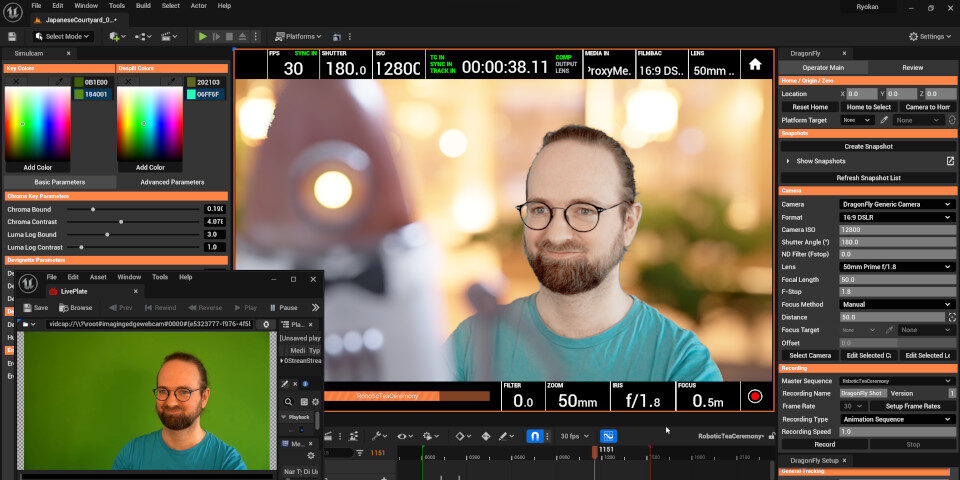Glassbox Technologies ships DragonFly 3.2
Orignally posted on 18 May 2022. Scroll down for details of the DragonFly 3.2 update.
Glassbox Technologies has updated DragonFly, its virtual camera system for Maya and UE5, adding a mixed-reality Simulcam mode to overlay CG elements on live plates in real time.
DragonFly 3.0 improves the accuracy with which the software simulates real-world cameras and lenses, and adds new options to edit already captured takes, and to record from the viewport.
A hardware-agnostic virtual camera system
Originally released in 2019, DragonFly enables directors and DoPs to scout CG sets in the same way as they would live sets, testing camera angles and exporting finished camera moves.
A free iOS app, DragonFly Companion, makes it possible to use an iPad or iPhone as a virtual camera, with the virtual camera view displayed on the screen of the mobile device.
It is also possible to control the virtual camera via a gamepad, or using HTC’s Vive controllers or Vive Trackers; and the software is natively compatible with OptiTrack optical mocap systems.
The software is compatible with Maya and Unreal Engine, support for Unity having been discontinued in 2021.

DragonFly 3.0: new Simulcam mode composites CG elements into live footage in real time
DragonFly 3.0 introduces a new ‘Simulcam’ mode, compositing Unreal Engine scenes into live footage in real time, making it possible to preview CG and live performances simultaneously.
The system is natively compatible with Vive Mars CamTrack, HTC’s new virtual production system, and features “one-click timecode and genlock set up”.
Better simulation of real-world cameras and lenses, plus workflow improvements
Simulation of real-world cameras and camera lenses has been improved, with support for anamorphic lenses and lens distortion, as well as ISO, shutter speed, frame rate, ND filter strength and aperture.
The software also now includes a dedicated window for editing stored camera profiles, with changes to settings previewed in the camera view, or on a standard checkerboard.
Other changes include the option to edit takes after shooting, making it possible to change the starting frame or camera settings; and viewport recording, making it possible to generate final renders directly as .mp4 files, rather than having to render takes in Unreal Engine.
DragonFly’s file naming convention has also been simplified, storing recording files with shot name metadata as a clear-text filename, and automatically creating JSON files containing metadata for the respective shot.
Updated 2 February 2023: Glassbox Technologies has released DragonFly 3.1.
The update makes snapshots and takes level-aware, with DragonFly automatically opening the correct level and sublevels; and lets users filter snapshots and takes in the Review panel.
New features include support for variable lens distortion, making it possible to mimic effects like focus breathing, and the option to import Unreal Engine ULens files.
Gamepad input now supports camera rotation – tilts and pans – as well as position changes.
Other changes include the option to specify a number of pre-roll frames when recording; and automatic syncing of overlays like grids and safe frames between the DragonFly viewport and the iOS app.
Updated 2 January 2024: Glassbox Technologies has released DragonFly 3.2.
The update adds support for additive recording, making it possible to combine multiple passes into a single take: for example, to override a focus pull while preserving a camera movement.
Users can also now freeze camera movement or rotation on individual axes.
For pipeline integration, the software can now connect directly to Vicon as well as OptiTrack motion-capture systems, and gets beta support for OSC (Open Sound Control) server input, making it possible to control DragonFly remotely from devices like Elgato’s Stream Deck.
The Companion app gets UX improvements, including multi-device support; and viewport streaming from Unreal Engine to the app now supports WebRTC as well as the NDI protocol.
Pricing and system requirements
DragonFly 3.2 is compatible with Maya 2020+ and Unreal Engine 5.1+.
Rental now costs $129/month or $850/year for node-locked licences, up $160/year since the release of DragonFly 3.0; or $149/month or $990/year for floating licences, up $40/year.
Perpetual licences cost $1,350 for a node-locked licence; $1,836 for a floating licence.
Read more about the new features in DragonFly on Glassbox Technologies’ website
